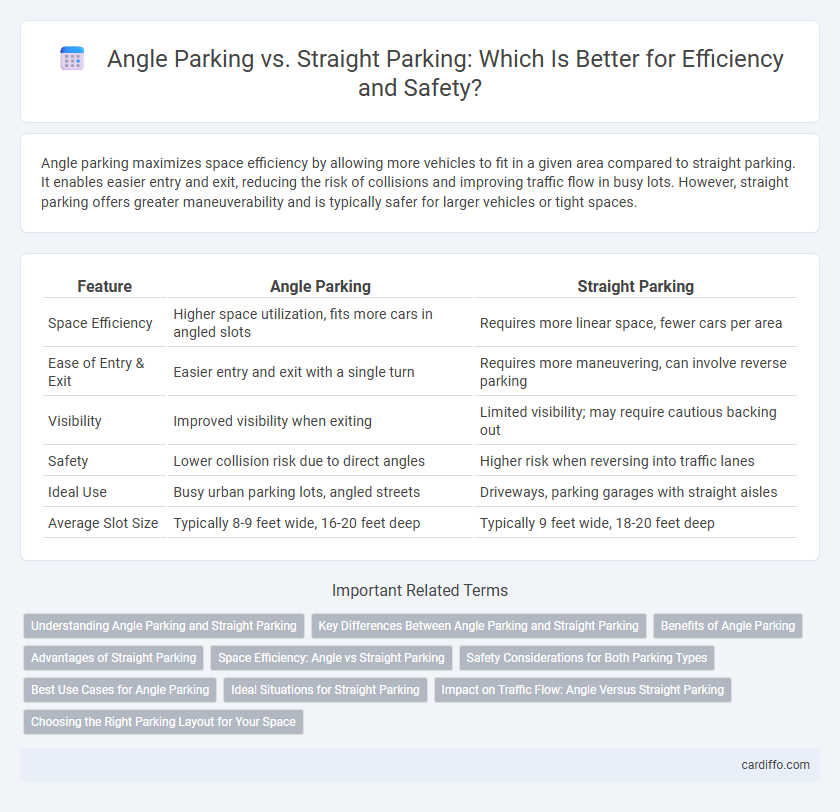Angle parking maximizes space efficiency by allowing more vehicles to fit in a given area compared to straight parking. It enables easier entry and exit, reducing the risk of collisions and improving traffic flow in busy lots. However, straight parking offers greater maneuverability and is typically safer for larger vehicles or tight spaces.
Table of Comparison
| Feature | Angle Parking | Straight Parking |
|---|---|---|
| Space Efficiency | Higher space utilization, fits more cars in angled slots | Requires more linear space, fewer cars per area |
| Ease of Entry & Exit | Easier entry and exit with a single turn | Requires more maneuvering, can involve reverse parking |
| Visibility | Improved visibility when exiting | Limited visibility; may require cautious backing out |
| Safety | Lower collision risk due to direct angles | Higher risk when reversing into traffic lanes |
| Ideal Use | Busy urban parking lots, angled streets | Driveways, parking garages with straight aisles |
| Average Slot Size | Typically 8-9 feet wide, 16-20 feet deep | Typically 9 feet wide, 18-20 feet deep |
Understanding Angle Parking and Straight Parking
Angle parking involves positioning vehicles at a specific diagonal angle, typically 30 to 60 degrees, which facilitates easier entry and exit in tight spaces and increases the number of parking spots available per row compared to straight parking. Straight parking, also known as perpendicular parking, requires vehicles to be parked at a 90-degree angle to the curb or aisle, maximizing space efficiency on wide lanes but often needing more maneuvering room to park and leave. Understanding the practical applications and spatial requirements of angle versus straight parking helps optimize lot design for traffic flow and vehicle capacity.
Key Differences Between Angle Parking and Straight Parking
Angle parking positions vehicles at a 30 to 60-degree angle to the curb, allowing easier entry and exit but requiring more space between rows. Straight parking lines vehicles parallel to the curb, optimizing space efficiency and permitting more cars to fit in a given area. Angle parking typically offers better visibility for drivers when reversing, while straight parking is preferred in high-density urban environments due to its compact layout.
Benefits of Angle Parking
Angle parking maximizes space efficiency by allowing more vehicles to fit within a given area compared to straight parking. It facilitates easier entry and exit, reducing the risk of accidents and minimizing vehicle damage. Enhanced maneuverability in angle parking improves traffic flow in busy lots and narrow streets.
Advantages of Straight Parking
Straight parking offers maximized space efficiency by allowing more vehicles to fit in a given area compared to angle parking. It simplifies maneuvering and reduces the risk of collisions during entry and exit due to its straightforward approach. This parking style enhances accessibility for larger vehicles, making it ideal for commercial and crowded urban environments.
Space Efficiency: Angle vs Straight Parking
Angle parking maximizes space efficiency by allowing more vehicles to fit within a given area due to staggered positioning, facilitating easier entry and exit in compact parking lots. Straight parking, while offering simpler navigation and higher ease of reverse maneuvering, often requires wider lanes and consumes more linear curb space per vehicle. Urban planners prioritize angle parking in constrained environments to optimize lot capacity and traffic flow.
Safety Considerations for Both Parking Types
Angle parking reduces the risk of collision by allowing drivers better visibility and easier access to adjacent spaces, but it requires careful maneuvering to avoid scraping nearby vehicles. Straight parking offers simpler entry and exit, minimizing the chance of side-swipes but can limit sightlines, increasing the risk of accidents with pedestrians or passing cars. Proper signage and marked lines enhance safety in both angle and straight parking, guiding drivers to park within designated spaces and maintain adequate clearance.
Best Use Cases for Angle Parking
Angle parking is ideal for high-traffic urban areas and shopping centers where maximizing space and quick access are essential. It facilitates easier entry and exit in narrow lots, reducing the chances of collisions and streamlining vehicle flow. Angle parking also minimizes the space required per vehicle compared to straight parking, making it well-suited for streets with limited curb length.
Ideal Situations for Straight Parking
Straight parking is ideal in high-traffic areas such as busy urban streets and large parking lots where efficient space utilization and easy ingress and egress are critical. It provides the most straightforward maneuverability, reducing the risk of collisions and making it suitable for compact vehicles and tight spaces. This method is particularly advantageous in locations with narrow aisles or where parallel lines define parking bays, ensuring maximum occupancy and orderly vehicle arrangement.
Impact on Traffic Flow: Angle Versus Straight Parking
Angle parking improves traffic flow by allowing vehicles to enter and exit spaces more smoothly, reducing the time spent maneuvering compared to straight parking. Straight parking requires more precise alignment and often causes delays as drivers must back out carefully, potentially obstructing passing traffic. Efficient angle parking designs can increase roadway capacity and minimize congestion in busy urban areas.
Choosing the Right Parking Layout for Your Space
Angle parking maximizes the number of spots in narrow or angled lots by allowing easier entry and exit, reducing the risk of collisions. Straight parking requires more space between lanes but offers greater maneuverability for larger vehicles and simplifies traffic flow. Assessing your lot dimensions, traffic patterns, and vehicle types ensures the optimal balance between capacity and convenience in your parking layout.
Angle parking vs straight parking Infographic

 cardiffo.com
cardiffo.com